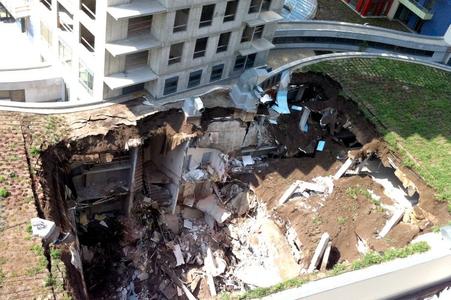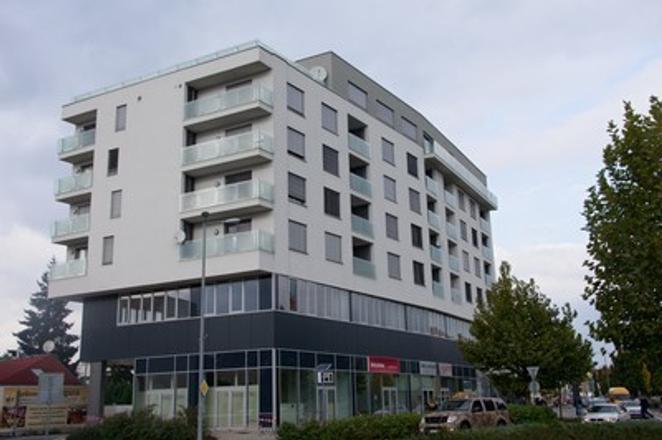While the roof of a garage of the 3nity development in Bratislava collapsed in 2012, the remaining two were emptied in October due to structural flaws and a danger of their collapse. Experts see pressure to reduce costs and construction times and insufficient supervision over increasing problems with statics of buildings.
“These problems are the tip of the iceberg for the 23 years piled-up problems in Slovakia’s construction sector, and its related legislation,” Ivan Pauer, president of the Construction Chamber of the Slovak Republic told The Slovak Spectator. “Each of the cabinets so-far has adjusted this law to its current commercial interests or needs of a bigger or smaller investor from abroad or some of the financial groups.”
Apollo, Centroom and others
Centroom is a building with more than 40 apartments, as well as offices and shops, in the centre of the spa town of Piešťany.
While it received the final building approval five years ago, the local construction office ordered on October 8 the building vacated due to structural flaws. The building, while there is a threat of its collapse, endangers not only its inhabitants but also its surroundings, the construction office said.
A similar fate impacted the office building Apollo Business Center 1 in Bratislava when its owner closed the building on October 17 and ordered all the tenants to move out over the danger of collapse. Among those affected were also the National Highway Company and the Agriculture Ministry.

And in the summer of 2012 the roof of a five-storey garage of the 3nity development in Bratislava fell down just two weeks before it was set to get final approval. The incident took place on a Sunday, averting injuries.

However, that was not the case when an unopened highway bridge collapsed close to Kurimany in November 2012, that left four workers dead and 11 injured. The incident occurred even as that section of the D1 cross-country highway had already supposedly been completed and the ribbon cutting ceremony had already taken place. An investigation is still pending.
The Apollo, Centroom and 3nity projects are connected with the name of one structural designer, Ján Tomčáni. After the collapse of the roof in 2012 he was stripped of his licence he held between 2001 and 2013 and charges were filed against him.
“That structural designer mentioned in the media has not been a holder of an authorisation stamp,” Ján Petržala, vice-chairman of the Slovak Chamber of Civil Engineers, told the Sme daily. “He was stripped of it.”
The Slovak Chamber of Civil Engineers (SKSI) is making a list of projects, in which Tomčáni was involved and as SKSI chairman Vladimír Benko told Slovak Radio on October 27, there are about 28 projects for now, but the list could grow.
Benko also pointed out that the problematic construction on Centroom and the Apollo Business Center were planned and designed on the free European Union market with designers proposing the cheapest construction to the detriment of safety and reliability chosen as the winner. Moreover,regarding these buildings, architects did not cooperate on creation of the design of the bearing structure with the structural engineer. Also, for these constructions unsuitable load-bearing structures were chosen, Benko told The Slovak Spectator.
Benko expects that the number of failed constructions will grown.
“The number of damages and failed constructions will statistically increase in all countries where planning, designing and realisation of constructions is left to free market regulation and where experts ceased to determine the quality of constructions and these have come under the pressure of the lowest prices of developers, economists and managers,” said Benko.
Benko also points to the danger brought on by software products generating ‘experts’ in construction without any practical experience.
“Their calculations without independent supervision along with the pressure of managers and developers to decrease the costs of a construction to the lowest level will accelerate the number of mistakes and failures,” said Benko.
Pauer of the Construction Chamber also points to missing oversight.
“Here I dare to point out the fact that while in case of production of cars and components for them each preparatory and production process is being supervised because safety and reliability is at question,” said Pauer. “Buildings, used a by much higher number of our population, do not need to have each preparatory and production process supervised…”
Pressure on prices
Experts see flawed legislation, cost cutting, and faster construction times as behind current problems.
Jiří Vacek, head of the CEEC Research company, sees reduction of prices to the detriment of quality as one of the most common reasons new buildings might be structurally unsound.
“This was visible especially in crisis years and we have been encountering consequences until today,” Vacek told the Hospodárske Noviny.
Based on a survey by CEEC Research from 2013, several companies reduced quality to improve the price when only 8 percent of respondents confirmed they were building above the secure price. Two-thirds said that they are building for prices that are on the border and one-quarter indicated that they are carrying out an order that they tendered for a price below a secure level.
Pauer also sees the drop in solvency leading to unbearable pressure on prices behind the current problems as well as the current system of certification of professional competence that he sees as imperfect.
What experts are criticising in regard to current construction legislation is the insufficient supervision of experts on construction sites while a brand new construction law should have addressed this issue, among other things. But in Slovakia 40-year old construction law remains valid, as Minister of Transport, Construction and Regional Development Ján Počiatek withdrew the draft law from discussion in parliament on September 22 amid criticism from the opposition.
“The new construction law gave new basic rules from the viewpoint of the administrative public law and it also contained proposals for safer construction,” Martin Kóňa, the ministry’s spokesman told The Slovak Spectator, adding that regarding the new law there was achieved the highest consensus possible. “Alas, due to various pressures its introduction into practice failed. Thus we are currently looking for all viable legislative possibilities to reflect these proposed changes in the currently valid legislation.”
According to Benko of SKSI, the draft of the new construction law already contained most of the systemic elements securing safety and reliability of constructions. On the other hand, according to Pauer of the Construction Chamber, the draft did not address the issue of the supervision throughout the whole process of preparation and realisation of a construction project. Moreover, the Slovak Association of Construction Supervision, whose legislative agenda the Construction Chamber took over in May 2015, prepared a concept and the framework of a brand new construction law already in 2013, but “for creators of the withdrawn bill it was probably better to re-work the old withdrawn ‘ready’ draft bill from 2006 dating to the Mikuláš Dzurinda government”.
“The problem in Slovak politics is that responsible officers do not want at all to negotiate with us and technicians,” said Pauer. “They communicate with us only under the pressure of media.”



 Centroom in Pieštany (source: TASR)
Centroom in Pieštany (source: TASR)